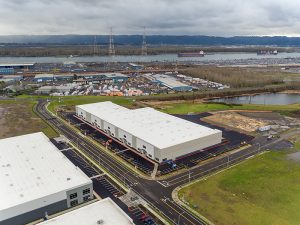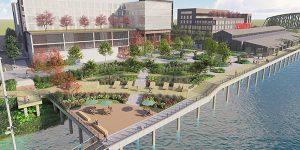Smart Growth: Important for Our Future
‘Going green’ means something different for everyone. It can be as simple as choosing recyclable options, traveling with a reusable water bottle, or taking steps to reduce utility usage. These are all great ways to be conscious of your individual choices, but how do you sustainably develop a port?
According to the SmartGrowth.org / US Environmental Protection Agency, “Smart growth” covers a range of development and conservation strategies that help protect our health and natural environment and make our communities more attractive, economically stronger, and more socially diverse.
At the Port of Vancouver, we have embraced smart growth with our new facilities and developments. Here’s a look at the various ways that the Port of Vancouver is leading the way in environmental planning and proactively making a difference in how we grow:
Centennial Industrial Building
The port’s Centennial Industrial Building (CIB) was completed in 2018 and is proudly advertised as Green Globes Designed and Built.

The Green Globes Certified Centennial Industrial Building at the Port of Vancouver
The Green Globes Building Certification is awarded by the Green Building Initiative for prioritizing sustainable development. Our modern industrial facility was designed to maximize efficiency, be environmentally conscious and provide a long-term benefit to the occupants of the building. CIB’s sustainable elements include a solar-ready roof, bird safe windows and lighting, skylights, native vegetation, enhanced stormwater treatment, and is EV station-ready.
In June of 2018, Hawthorne Hydroponics LLC signed a five-year lease for CIB. The port has partnered with Hawthorne on the installation of high-efficient, occupant-sensor lighting to continue sustainability efforts.
“Our previous manufacturing building was hot and too small for our needs,” said Hawthorne Plant Manager Garry Appleberry. “The new Centennial building is much cooler, thanks to its energy-efficient design and the fans we installed when we moved in. It has plenty of space for our workers, and the skylights add great natural light. This, plus the LED lights and motion sensors, enables us to consume less energy and provide our workers with a safe and pleasant place to work.”
Another great example of Smart Growth at CIB is Hawthorne’s efforts to green their manufacturing operations as much as possible. In addition to recycling cardboard and pallets, they have introduced a new process for recycling plastic trimmings from their trays.
“Each manufactured tray has about 3 inches of waste trimming that we save and pass on to a local business that grinds it down into pellets that are then recycled into new trays,” said Appleberry. “This has resulted in nearly 400,000 pounds of plastic being kept out of landfills since October 2018.”
Smart Growth takes many forms and the port is proud to offer sustainable space to tenants who continue to move toward environmentally responsible practices.
Terminal 1 Certified LEED-Neighborhood Plan: Gold Level
As the port develops our Terminal 1 waterfront project, we’ve been incorporating sustainable practices and thoughtful designs. As of September 2019, we are pleased to announce that the project was certified LEED-Neighborhood (ND) Plan at the Gold level by the US Green Building Council (USGBC).

A rendering of the Vancouver Landing design at Terminal 1
LEED stands for Leadership in Energy and Environmental Design and is the most widely used green building rating system in the world per USGBC. The certification is a globally recognized symbol of sustainability achievement and encourages healthy, highly efficient and cost-saving green buildings. The port’s LEED-ND designation is a particularly notable achievement, as it looks beyond a specific building and recognizes an entire ‘Neighborhood Development’ for its sustainability practices and planning.
LEED designation is not easy to achieve. Throughout a rigorous review process, applicants receive points for various innovative and sustainable practices including location selection, neighborhood design, and green building efforts. For the Terminal 1 site, the port proactively planned and designed for a reduction in water use, protecting wildlife, increased energy efficiency, pollution control, heat island reduction, waste management and more.
The port has committed in its Terminal 1 design standards that all new buildings will be constructed to a minimum LEED Gold Certification or better. Our goal is to attract environmentally conscious partners by offering a sustainable neighborhood to call home. Vesta Hospitality’s Terminal 1 Hotel project will be the first project constructed on the site and will feature sustainable development strategies during construction and upon completion. The project broke ground earlier this year, and the seven-story, 150-room hotel is expected to be complete in 2021.
Additionally, the port is in the negotiation stages with a second developer, Lincoln Property Company West, who unveiled design proposals at a commission workshop earlier this year. For more information on the Terminal 1 project, visit DiscoverTerminal1.com.
Continued Sustainability Efforts 
The port formalized our sustainability efforts in 2008 with the “We Can!” project. We Can! recognizes our past sustainability accomplishments and serves as a template for measuring future changes to improve the programs already in place. On a regular basis, the port produces a Sustainability Report that helps evaluate the health of the economy, our community and the environment in relation to our sound practices.
Read our latest Sustainability Report and learn more about our sustainability program here.
Smart Growth encompasses the development, environment and community, and the Port of Vancouver is proud to continue these efforts in the Terminal 1 development and beyond.
